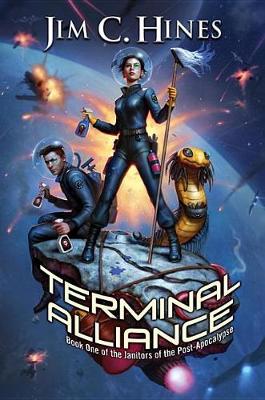
Terri M. LeBlanc
Written on Oct 4, 2017
I received this book for free in exchange for an honest review. This does not affect my opinion of the book or the content of my review.I’ve been a fan of Jim C. Hines for a long time. In fact, long time followers of this blog know that Jim is one of the first authors I made a point of connecting with at a science fiction and fantasy convention several moons ago and the rest is pretty much history.
I’ve read most of Jim’s books (saving the Jig series because I just have not been able to connect with that loveable goblin), and basically I comes down to the fact that I love worlds Jim creates or recreates. The Princess series, fitting solidly in the fantasy genre, takes well-known fairy tales and casts the helpless princesses as kickass heroines who write their own happy endings. The Magic Ex Libris series covers urban fantasy (magic in the known world) and fulfills every bookworms’ dream of bringing their favorite objects to life while examining topics likes diversity and human rights. Terminal Alliance is yet another jump for Hines, this time into the realm of science fiction as he charts the journey of some very heroic space janitors. Yes, you heard me right, space janitors.
Jim has been known to tackle tough issues for several years. He is continuing this trend in this new science fiction series, Janitors of the Post-Apocalypse, by asking his readers, “What does it mean to be human?” The twist is Hines is creating a completely new world populated by strange non-humanoid-lookings aliens who think humans are beneath them. Part Star Trek and part Galaxy Quest, Terminal Alliance follows Marion “Mops” Adamopoulos and her crew of space janitors, plus one genial alien, on their quest to determine the truth about the downfall and apparent rescue of the human race from a disease that sounds a lot like something out of The Walking Dead.
Overall the story and adventure in Terminal Alliance is great. The mystery surrounding what happened on Earth during First Contact is revealed in a way that makes sense—not too slow and not too fast. Mops always seemed to be on top of what I was actually thinking as a reader. She was also a strong leader and did her best to put on a strong face for her crew, and there were times where her vulnerability showed as well. This made her a real character and a real leader.
The only downside to this book, for me, is its roots in science fiction. This is a genre, along with epic or high fantasy, that I have always struggled with. The minute a story starts “to explore strange new worlds, to seek out new life and new civilizations” my brain struggles to see the exotic new life forms, the worlds they live in and the ships they fly based on the descriptions on the page. Thankfully, with Terminal Alliance, much of the time was spent with Mops and her human crew so I didn’t spend a lot of time with a wrinkled brow trying to figure out what the aliens looked like. I was absorbed in the story and the ongoing conspiracy related to the demise of the human race.
The strength in Terminal Alliance comes from its three-dimensional characters and the questions asked about what makes humans human. As Mops and her crew piece together the truth, you are taken on a grand adventure across a wild universe where humans are not at the top of the power tower — something not often seen in books, television or movies. Using everything in their tool belts, from “high-pressure canisters of disinfectants, paints and sealants,” Mops and her band of misfits strive to reveal the truth about what happened to humanity with tenacity, grace and a little humor. It’s a wild and enjoyable ride.
This review was originally posted on Second Run Reviews
